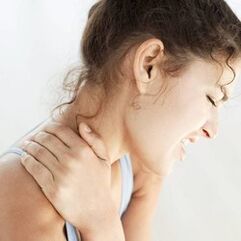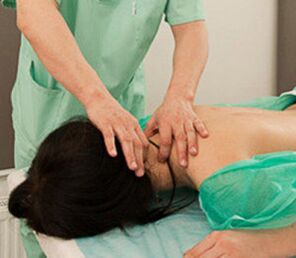Osteochondrosis is degenerative-dystrophic disorders in the tissue of the cartilage of interfaced joints, causing their deformation and destruction.Osteochondrosis can be developed in one or more spine.Osteochondrosis of cervical regionsIt especially occurs often, and sometimes provides very serious complications.

Features of osteochondrosis of cervix
Due to the characteristics of the cervical spine structure, the course and symptoms of osteochondrose in this segment have a number of characteristics.Spine of the cervix of a small moving spine, which continuously undergo a significant and long load.The vertebral canal in the cervical area was called, so that the compression of spinal cords in this segment develops much more often and leads to pretty serious lesions.In the neck there is a large accumulation of nerve endings and blood vessels, including the spine, which provides cerebellum nutrition, oblong brains and rear part of the brain.Violation of blood flow in this artery leads to impaired coordination, dizziness, reduction in vision and hearing, and in difficult cases, stroke may develop.
Symptoms of osteochondrose cervix
Osteochondrosis of cervical regionsThe spine manifests several syndrome:
-
Reflex and irritated syndrome
Burning pain in the cervical kingdom, the A-Consuming region, which forms after sneezing, heading the head or long static state, for example, after sleep or a subsequent movement of the head or door - often appeals with osteochondrosis cervix spine.Pain can radiate to cage on shoulder or chest. Narrow spinal channel syndrome (stenosis of spinal channel)
This syndrome develops as a result of the compression of the spinal cord and its vessels, leading to circular disorders in the affected area and the development of minesopathies - rare, but most of the complexes of osteochondrose.Verta -Carbon Grlićska Mikalna Minik is created mainly in medium and older people as a result of the compression of spinal cord or its back osteophytes, thickened yellow ligament, kili on semers.The disease is developed gradually, initially, the pain and restriction of movement in the Grlić spine are often observed.In the future, cervical osteochondrosis can cause damaged upper and / or lower extremity functions, manifested, with a feeling of twisting, a sense of cotton legs or weapons, to development of paresis and paralysis-
Rook syndrome
Events of radicular syndrome in osteochondrose of the cervical spine will depend on which compression is cited by the nervous root as a result of structural changes on the disc.However, in any case, cervical osteochondrosis will appear with a headache that have pain, pulsating or burning character, sometimes liquid in the type of hypertension.Back pain is rarely local and usually gives shoulder, forearm, shoulder and / or arm, to fingers of brushes.
Depending on the affected spine segment, the following symptoms can be:
- C1-C2: Defeat in this segment, as a rule occurs as a result of automotive injuries and is manifested by violating smells and speech, hypotrophies of persons and sublingable muscles and reduction in the occipital area.
- C2-C3: It is rarely affected and was accompanied by damaged hearing, vision and the control of the language of the language, which leads to a disorder of speech and appearance of inflammation, sweating or lump in the throat.
- C3-C4: Since the diaphragematic nerve is withdraws in this segment, except the pain in the piano and shoulder GPU, unwanted linen and trapezoidal muscles, pain in the right hypochondration and heart are also disturbed.In addition, goncheability, a sense of congestion of nasal congestion, snoring, odor reduction, facial muscles, deteriorating tooth condition can be developed.
- C4-C5: The defeat in this segment monitors painful sensations in the shoulder shoulder, the hypotrophy of the deltoid muscle, reducing the sensitivity of the outer surface of shoulders, shoulders and skeptical muscle inflammation in this area.Among other symptoms, voice changes may appear, the feeling of inflammation in Grkljanx, snoring.
- C5-C6: The segment is most often subject to degenerative-dystrophic lesions and has extensive symptoms.First of all, pain and damaged skin sensitivity with shoulder blade, the outer surface of the shoulder to the radial surface of the forearm and the manual hand is developed.Subsequently, somatic symptoms are developed, including frequent and weakly subject to lung and bronchi treatment, including asthma, rheumatic and allergic events, angina symptoms.
- C6-C7: The lesion of the nerve roof in this segment leads to the appearance of the skeptula, the back surface of the shoulders, along the sub-renowned surface forearm to the back of the hand.In addition, damage to this segment can monitor symptoms that match thyroid disease, mediastinal organs and the cardiovascular system.
- C7-T1: The lesion of the spine C8 monitors the three-headed muscle hypertrophy and the divert finger, which leads to the weakening of the flexible reflexes and pain with the sensitivity to the skin from the neck, shoulders, to the shoulders, to elbow and small finger.In severe cases, symptoms can be developed as with angina pectoris, arrhythmias and asthma.
-
Cervical Cervical Syndrosrosis
Cardian syndrome develops with irritation of nerve roots that imposed the diaphragm (diaphragmatic nerve) or large chest muscle.Symptoms are definitely an identical attack of angina pectoris, but at the same time the attack lasts unnatural, the pain is enhanced by sharp movement of the head or neck, with sharp кихом ра каши каши каши каши кошим.Standard Koronarijanolicytics do not make relief, and the ECG at the time of the attack does not show a breach of coronary circulation.At the same time, heart syndrome can be accompanied by tachycardia, arrhythmias and high blood pressure. -
Vail Artery syndrome
This syndrome is one of the most common and more dangerous eventsOsteochondrosis of cervical regionsStitch.This syndrome develops along the background of the spine and the vasculator disorders in the appropriate areas of the brain (cerebellum, brain and rear lobes), which determines the clinical picture.
One of the main manifestations of the vertebra syndrome is strongly pulsed and / or burning headaches, permanent or paroxysmal, exciting darkness, exceeded part, whiskey and rear of the head.Usually pain can be one -ssid.In the first phases of development, headaches appear or intensified after a long stay in an unpleasant position with head back, after physical effort or after sudden movements.With the narrowing of the lumens, the artery of pain becomes more pronounced and more common, sometimes permanent.In severe cases or at the peak of headaches, vomiting may occur, fainting is not excluded.
Visual disorders with cervical osteochondrose can occur separately and on the background of headaches and expressed in the weapon pain, damaged vision sharpness, a feeling of veils before eye, dryness or furnace in the eyes.One of the characteristic symptoms of tears of the vertebrate artery are sudden short attacks of dizziness or loss of orientation in space.Such attacks occur for a few seconds and pass fast.There may be a sudden noise in ears or pulsation in the head space.Also, the damage to the vertebrae can lead to the development of heart syndrome.
In severe cases, the attack of "ischemic attack," manifested heavy headaches, vomiting, loss of movement, the change of manuscripts, gears, dual, weakened speeches and balance, can be developed.
Diagnosis of osteochondrose cervical spine
The doctor may be adequate to the osteochondrose of cervix but in the first testing of the patient, as well as determine the level of affected spine, anatomical characteristics, including posture, the line of spicy processes, the lower back of the shoulder;Localization, nature and degree of pain syndrome;Spine amplitude, relief and muscle tone.
The diagnosis is specified using visual diagnostic methods (radiographic studies, CT, MRI), which allows you to determine the disease phase, spinal lesion level, the exact localization of the deformed disk.And based on this data, the most optimal treatment of cervical osteohondrone is selected.
Treatment of osteochondrosis of cervix

Surgical and conservative methods are used in the treatment of cervical osteochondrosis.But surgical treatment is prescribed only in the presence of heavy complications that occur in later stages of osteochondrose if:
- stenosis was formed (narrowing) of the spinal canal;
- The vertebral artery is suppressed;
- A significant hernia or protrusion is formed, compressing nerve roots;
- Excessive instability of the developed spine.
In other cases, the standard of treatmentOsteochondrosis of cervical regionsSpine is conservative therapy.This is due to the fact that all the achievements of modern medicine are not always expected by the consequences of surgical intervention.
Conservative treatment of cervical osteochondrose
Best results in treatmentOsteochondrosis of cervical regionsSpine, as well as other types of osteochondrose, is achieved when you see a doctor.Unfortunately, many patients often do not attach importance for light discomfort in back or periodic headaches.On the other hand, there are still many cases of irregular diagnosis and long useless treatment, sinceOsteochondrosis of cervical regionsThe spine can simulate other diseases, such as arthritis, myalgia or angina pectoris.Therefore, rechargies recommend checking the spine in the presence of symptoms of any disease, especially accompanied by pain or spine.
In an efficient treatment of cervical osteochondorosis, an integrated approach of great importance, including the following instructions:
- Drug therapy- focused on improving the trophies of the intervertebral disc and pain stops, removing muscle spasm and inflammation during worsening.For these purposes, non-asterical anti -infalmator drugs, analgesics, muscular relaxants, choncraft prescribe to encourage the reconstruction of cartilage and multivitamine and vitamin group b;
- physiotherapy- prescribes to reduce pain, improving the nutritional disk tissue tissue, encourage the cartilage regeneration processes, removing muscle cramps, inflammatory processes in the postoperative period for speedy recovery;
- Hand therapy- Used to remove muscle cramps, reduce pain, improve blood metabolism and lymph, keeping a hold and improve joint amplitude.The manual exposure scheme was selected individually for each patient;
- massage- a long-used and well-established method for the treatment of muscle-bone system diseases.Has the same effect as hand therapy;
- Medical physical educationIt is one of the most important methods of treatment of all types of osteochondrose, including osteochondrose of the spine.The purpose of the therapy exercises is the release of muscle spasm and the compression of nerve roots, improve blood flow and lymph in spine, strengthen muscle framework and increase the flexibility of liga.A set of exercises was selected for each patient, whose correct implementation has been accompanied by a specialist;
- reflexologyIt refers to an alternative type of treatment, widely used today and provides a very good result in combination with other treatment methods.The essence of the method is an impact on acupuncture points and / or reflexogenic zones to achieve the same results as well as other therapeutic methods (reduction in muscle pain and spasm, as well as to improve sleep, mitigate psycho-emotional surges, and so on.

Hitoprotectors, vitamins, vitamins, and drugs for external use - fats, creams, gels that contain NSAIDs, local stimulants for regeneration of meters and tissues were used.
In addition to the main methods of treatment, with osteochondrose of the cervical region, the patients are recommended to change the usual lifestyle, because in most cases, the disease continues against low mobility, poor or malnutrition, clear little weight and presence of bad habits.In most cases, in the early stages of cervical osteochondorosis, it is sufficient to make a healthy lifestyle and overload muscle regions with the uterus, to stop the continuing development of the pathological process, and even achieve recovery in the first phase.



















